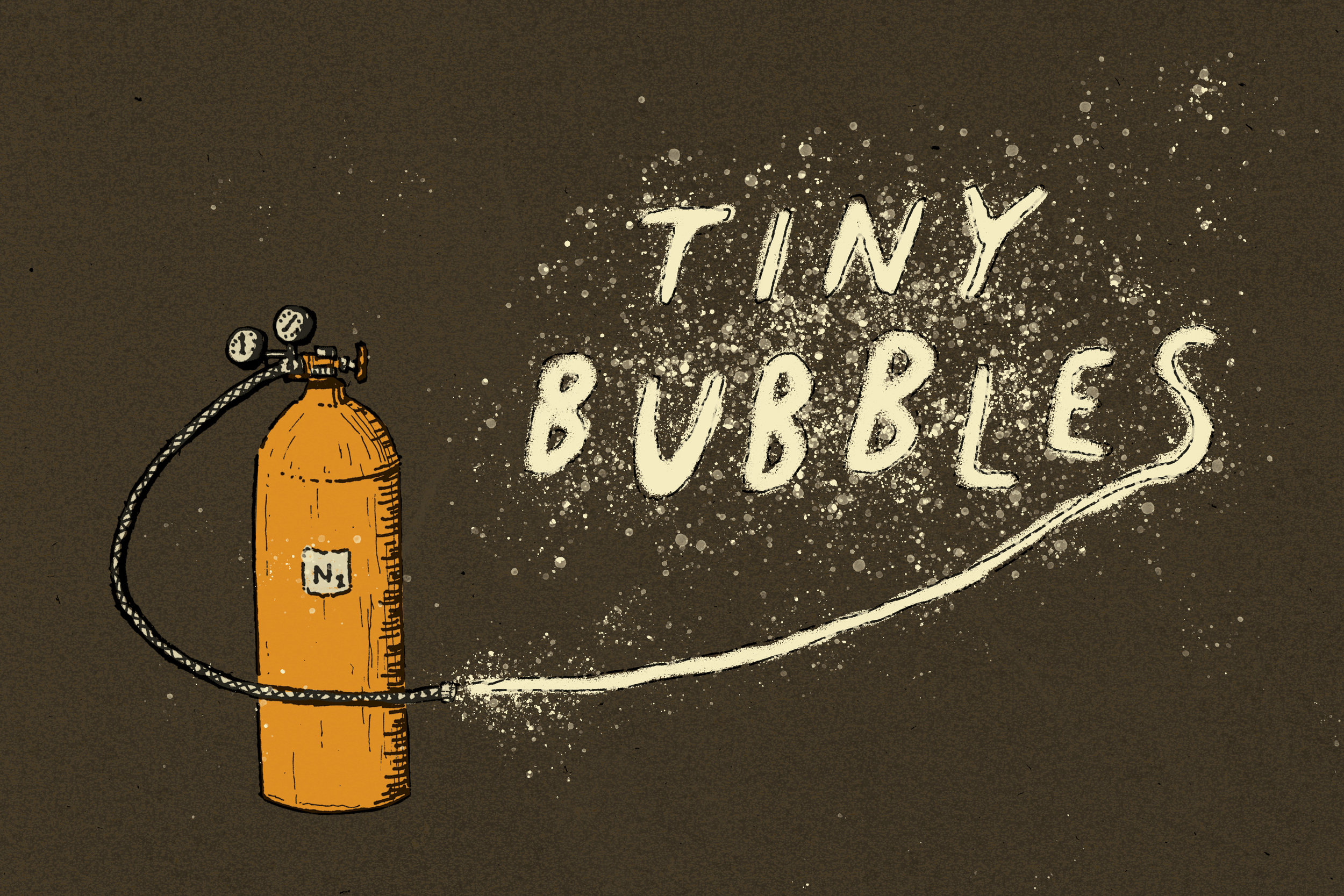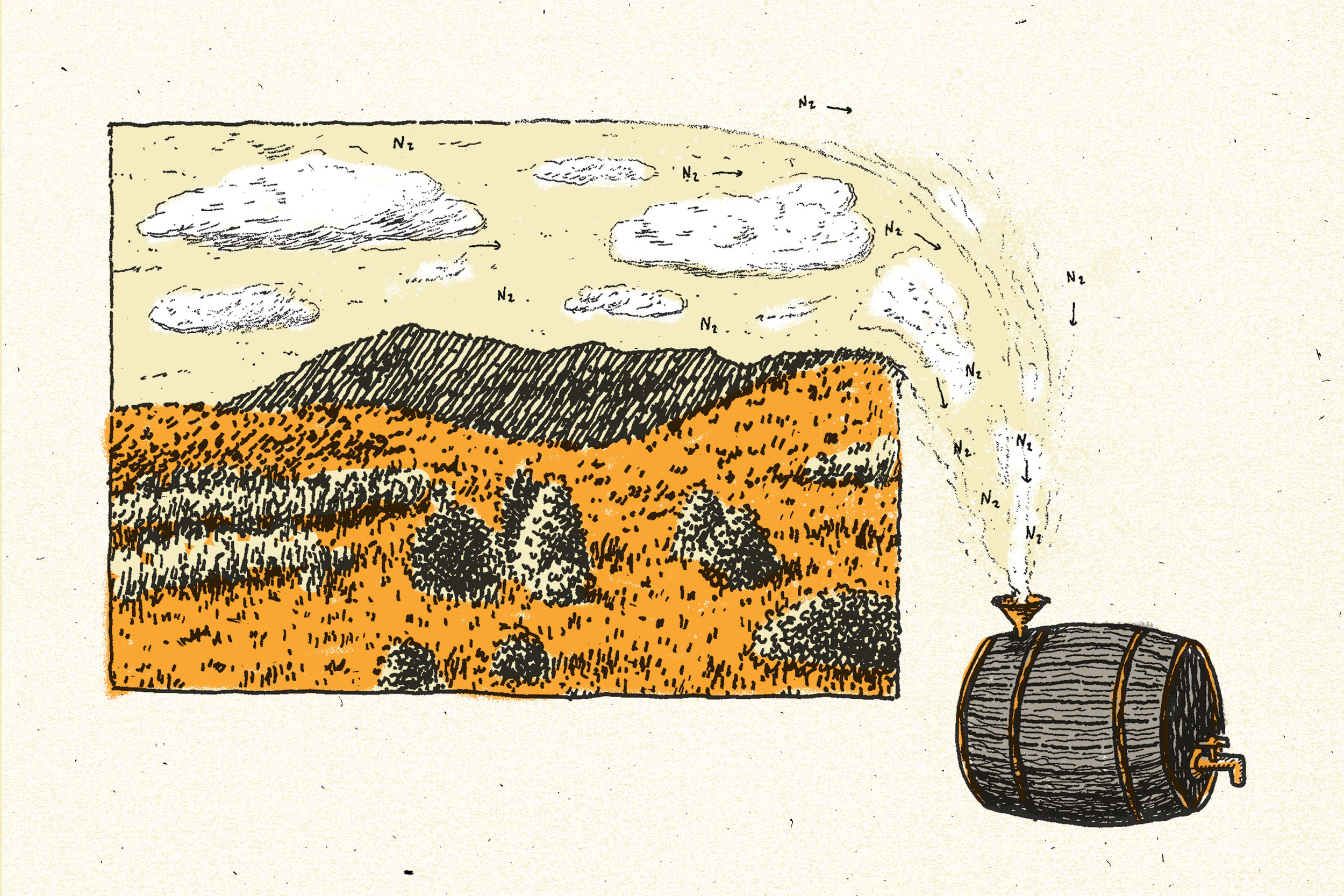There are three words in the name of Left Hand Brewing Company’s best-selling beer, but on the tap handle, only one of them is large enough to read from the far side of a bar. You’ll probably spot the brewery’s red hand logo, but it’s that one big noun that stands out. It’s not “milk,” and it’s not “Stout.” It’s “nitro.”
“Nitro, and then being able to package nitro, was basically a key part of us having double-digit growth for many years in a row,” says Left Hand president Eric Wallace. “It just launched things.”
With its Milk Stout Nitro, Left Hand provides the unusual example of an American craft brewery whose flagship beer isn’t an IPA or some other hop-forward brew. It’s also a beer whose name actually emphasizes the gas that dispenses it, rather than where it’s made or its principal ingredients.
But these days, Milk Stout Nitro isn’t the only beer with “nitro” in its name. RateBeer lists more than 500 nitro Porters and nitro Stouts, among them Nitro Knight, Nitro Hum, Nitro Noir, and Neptune’s Nitro. All are named in honor of—and packaged with—nitrogen: a tasteless, odorless, and colorless gas, and the element that makes up 78.1% of Earth’s atmosphere. (Meanwhile, RateBeer lists zero beers with “carbon dioxide” in their names.)
The fact that nitrogen-dispensed beer has become a major part of contemporary craft is especially surprising when you consider that nitrogen dispense, or “nitrogenation,” was invented just 60 years ago by Michael Ash, a young Cambridge mathematics graduate working at Guinness’ Park Royal Brewery in London. And at the time, Michael Ash was supposed to be working on something else.
“He was such a hero for Guinness,” says Eibhlin Colgan, archive manager at Guinness in Ireland, when asked about nitro’s inventor. “Michael Ash is well remembered, because he did so much for inventing draft Guinness and nitrogenation.”
[Disclosure: Guinness is the GBH underwriter that supports this series, Mother of Invention.]
Ostensibly, the father of nitrogen-dispensed draft beer—and thus all nitro beer—wasn’t supposed to be working on draft beer at all. After being hired by Guinness in 1951, Ash worked in various departments before being put in charge of the brewery’s Sample Room in 1955, where he led a 20-member team. Their task: improving the shelf life of bottled Guinness. At that point, bottled beer made up the vast majority of how Guinness was served, usually in bottles that had been filled by pub owners.
“For the first 200 years we brewed, the beer left the brewery in wooden casks, [and] the publicans literally in the back room of their bars used to open the cask and bottle the beer themselves and then have the beer there on the shelf, usually at room temperature,” Colgan says. “And as a consumer going into the bar, that’s how Guinness was presented to you in the bar—in a bottle at room temperature.”
The problem? Draft beer was growing in popularity in the U.K., especially draft Lager.
“There was a huge rise in the popularity of Lager, especially coming in from the Continent,” Colgan says. “Consumers going into the pub were getting used to a beer that was served quickly and that the beer was cold.”
Draft Guinness, when it existed, was not something that could be served quickly, and the bottles on the shelf were generally not cold. The beer was considered “too lively” to be served on draft via carbon dioxide, according to an internal document at the brewery. Some publicans did serve draft Guinness, using a mix of two sources: one from a high-pressure cask on the bar and a second, low-pressure cask under the bar. Unfortunately, achieving the right pressure in the casks and the right mixture in the glass was an inexact science, and generally not speedy. The brewery had been trying to crack what it called “the Draught Problem” as early as 1932, but in 25-odd years it still hadn’t found a workable solution.
“Michael decided that he wanted to tackle this problem and launch a draft Guinness that could be easily served by anybody behind the bar,” Colgan says. “He always talked about himself as coming at this issue as a mathematician.”
Initially, he enlisted two of his team members to help him on a side project that some of his colleagues sarcastically dubbed “Daft Guinness.” Their solution—nitrogen—was literally commonplace, employing the most common gas on Earth, and one which, it was thought, wouldn’t affect the taste of the beer. By September of 1957, Ash had developed his first prototype for a two-chamber cask. One part held beer, while the other section stored a mix of nitrogen and other gasses. Guinness received a patent on the two-chamber cask in 1958, and the fourth iteration of Ash’s cask, known internally as Mark IV, launched in test markets in June of 1958. It was called the Easy Serve cask, and following its initial success it was widely launched in time for the brewery’s bicentennial celebrations in 1959.
The brewery’s management was thrilled with the results: outlets that had the new, nitrogen-based system saw a 20-25% increase in sales. According to Bill Yenne, author of Guinness: The 250 Year Quest for the Perfect Pint, nitrogen “breathed new life” into Guinness.
“It was a real game-changer for Guinness Stout, which was previously available most places only as a bottled product,” Yenne. “It was a very important milestone in the evolving story of Guinness as a global brand because it made a very unique draught product available worldwide, especially in the key American market.”
Although the gas itself is tasteless and odorless, adding nitrogen actually did do something to change the beer. Nitrogen gas doesn’t easily dissolve in water, and it creates much smaller bubbles than regular CO2. This helped to create a remarkable head in the new draft Guinness. In Yenne’s book, Guinness master brewer Fergal Murray is quoted as saying that it resulted in a slightly different flavor profile and an improved mouthfeel.
“I guess that’s it, if you talk about a nitro beer, it’s that creamy head and texture that people really respond to,” Colgan says. “From our point of view, draft Guinness pretty much proved such an overnight success throughout the 1960s and 1970s that it became the style of Guinness that everyone knew in the Western world.” (The brewery also produces different styles of beer for Africa and other markets.) “So that led Guinness to look at how to make Guinness in a can. That’s where the development of the widget came from.”
The widget marked another big step for nitro: the ability to package nitrogenated beers in cans. Guinness patented its first version of a widget in 1969. Over the next few decades, the widget evolved, eventually appearing in cans ranging from Boddingtons Draught Bitter to John Smith’s. The current version is a white, plastic sphere, just slightly smaller than a ping-pong ball, which releases nitrogen when the can is opened.
That’s not the only source for packaged nitro today. A few years ago, crowler and mobile-canning powerhouse Ball started offering its own version of a nitro widget, which, in a nod to old Intel commercials, it calls Widget Inside. Widget-free canned and bottled versions have also become more popular in recent years, though Left Hand’s Eric Wallace notes that skipping a widget requires a lot of care.
“We developed this pour-hard method, so that we didn’t need a widget or a floaty ball or whatever you want to call it,” Wallace says. “You gotta be able to measure everything, you gotta know what you’re doing. It’s expensive and it’s not easy. And we screwed it up every way we could screw it up, until we figured it out.”
In addition, nitrogen gas is available almost everywhere for draft lines. Six decades after the invention of the two-chamber Easy Serve cask, pub owners can now buy Guinness-style “G-mix” gas with 75% nitrogen for tapping whichever beers they like, though care must be taken to ensure the correct CO2 level of the tapped beer. Germany’s Linde sells two versions of its Biogon gas with nitro: a 50-50 blend and an 80-20 split of nitrogen and CO2, which, in the Czech Republic, is often used to push classic Bohemian Lagers through a side-pull tap. The tiny bubbles that were once a cutting-edge discovery at one brewery in London are now available to almost any brewer or bar owner who wants to use them.
With Ball’s launch of Widget Inside cans in 2015 and beers like Firestone Walker’s Nitro Merlin Milk Stout arriving in widget-free cans earlier this year, it’s clear that nitro is currently riding a wave of popularity. But that’s not to say it’s right for every style of beer. Sam Tierney, the cellar manager at Firestone Walker (and the man in charge of the brewery’s nitro process) notes that, while nitro works well for Stouts and Porters, it might not be the ideal choice for more hop-forward styles.
“Nitrogen doesn’t carry aromatic compounds as well as carbon dioxide does, so beers relying more on aroma are diminished by nitro,” Tierney says. “IPAs can be interesting on nitro because the bitterness is rounded out, but the aroma always suffers, and we’ve found that most people prefer normal conditioning. Overall, I think that nitro is best limited to British and Irish beer styles that were developed around cask dispense as it most closely mimics cask beer pulled through a hand pump.”
At Firestone Walker, that meant a special, lactose-laced version of its Velvet Merlin oatmeal stout.
“With a beer like Nitro Merlin, the nitrogen along with lower carbon dioxide levels creates a less acidic, less acrid profile, leading to a sweeter balance in the beer,” Tierney says. “The nitrogen also promotes a creamier foam. The overall impression is a richer, creamier, smoother and sweeter beer, versus normal carbon dioxide conditioning.”
Though the taste, texture and aroma of nitro beers get the most attention, nitrogenation also appeals to the other senses. Todd Usry, president and head brewer at Colorado’s Breckenridge Brewery, points out the visual and aural impact of nitro in beers like Breckenridge’s Nitro Irish Stout.
“What I tell people is that it’s a beer theater for the senses,” Usry says. “It starts with sound, it starts with cracking the can open, and you get this whoosh sound. Then you get this dolloping sound, if that’s a word, with the beer hitting the glass. And then you watch the cascade and the head forming, and that’s beautiful. The cascade has almost lava-lamp qualities.”
At Breckenridge, Usry said, sales of nitro beers were up about 17% in 2018. At Left Hand, Milk Stout Nitro is by far its most popular beer. But not all brewers are crazy about nitro, partly because of the difficulties. Off the record, many brewers will tell you that they straight-up hate using nitro, simply because of how precise everything has to be.
“We call it a gnat’s ass tolerance,” Usry says. “You’re really looking at dissolved oxygen content, you’re looking at CO2 from fermentation, and you’re looking as something as small as a gnat’s ass that can make a huge difference in the final product.”
At Left Hand, Eric Wallace says that the brewery’s success with nitro came as a big surprise. Looking at the size of the nitro category today, it’s hard to believe that Left Hand’s Milk Stout Nitro only launched on draft in 2011.
“At the time, there was very little in the way of nitro out there,” Wallace says. “A few imports—Guinness, of course, and Old Speckled Hen. And it started out out-of-state. Our sales really started taking off in the Southern states, and we were just trying to figure out what the hell was going on.”












